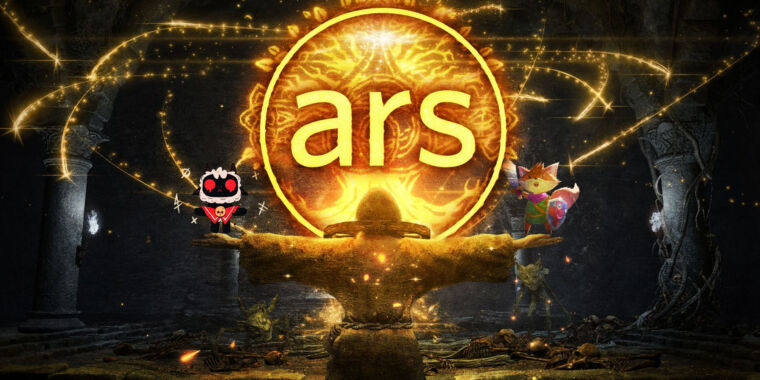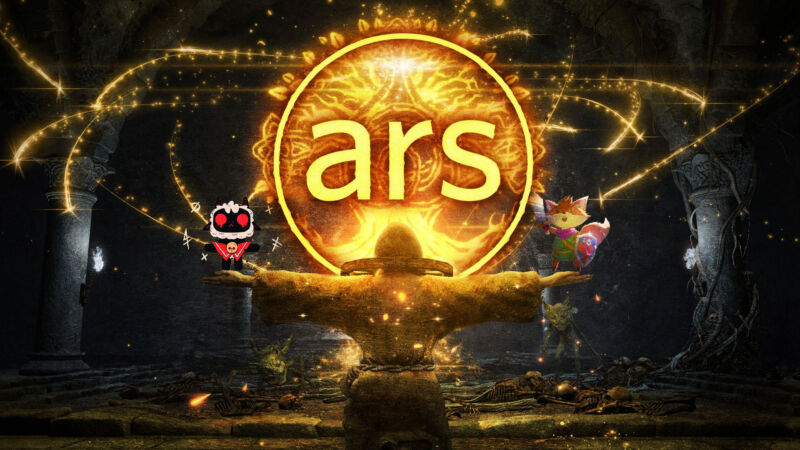
Collage by Aurich Lawson
2022 was a bit of a weird year for video games. For a start, quite possibly the most anticipated game of the year came out in March, well ahead of the usual holiday season rush of releases. But that holiday rush was itself muted this year, thanks to delays of big-name franchises from Diablo to Starfield to The Legend of Zelda.
That’s led some commentators to call 2022 a “slow year” for a games industry still recovering from the development chaos of COVID. And it’s true; we did have some collective trouble getting to our usual selection of 20 games for this year’s best games list, a possible sign that there were fewer “obvious” picks than usual.
Looking over the selections that did make the 2022 list, though, it’s hard to feel like the collective industry has let us down in any way. The relative lack of big-budget blockbusters allowed plenty of independent games a chance to shine, including those that made this list on the strength of brave new ideas in gameplay or storytelling. All told, the games listed below will stick with us for a long time and speak highly of the game industry’s continuing creativity and resilience.
This year we chose to list our gaming picks in alphabetical order, with a single “Game of the Year” pick at the end. Here they are.
Atari 50: the Anniversary Celebration
Digital Eclipse; Windows, Switch, PlayStation 4/5, Xbox One/Series, Atari VCS
It’s rare for a compilation of retro games to be considered for Ars’ annual Game of the Year list. It’s unprecedented for such a game to actually win one of our coveted spots. But Atari 50 does a couple of crucial things to separate itself from the countless classic game emulation collections that have proliferated over the years.
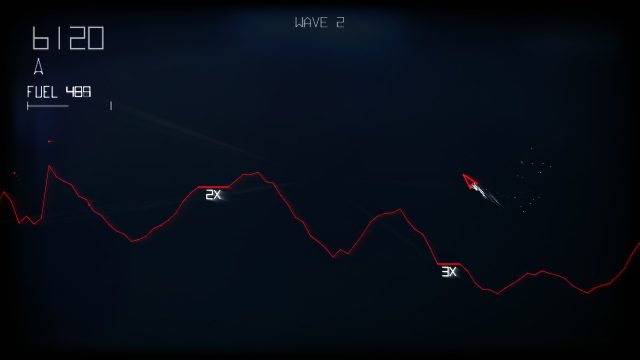
The first is an intense focus on supplementary materials. Atari 50 is packed with video interviews, design documents, contemporaneous advertisements, trivia, quotes, and more. It all gives crucial context to Atari’s 50-year history, and makes even the least playable games in the collection more interesting from a historical perspective. The “timeline” presentation is also top-notch, making the entire product feel more like an interactive museum than a simple collection of old titles.
Atari 50 also shines in its half-dozen “reimagined” versions of a few Atari classics. These feature updated graphics, sound, and gameplay that takes advantage of decades of advances in game design and technology, giving old concepts fresh life for a new audience. While these offerings aren’t all winners, the addictive action of Vctr Sctr alone is enough to warm the heart of any old-school arcade game fan.
-Kyle Orland
Cult of the Lamb
Massive Monster; Windows, Mac, Switch, PlayStation 4/5, Xbox One/Series
Here’s a weird statement: There aren’t enough cult simulators out there. There are, however, plenty of roguelites. Cult of the Lamb is both, and while it’s a good roguelite, it’s the cult simulator part of the package that made it stand out this year.
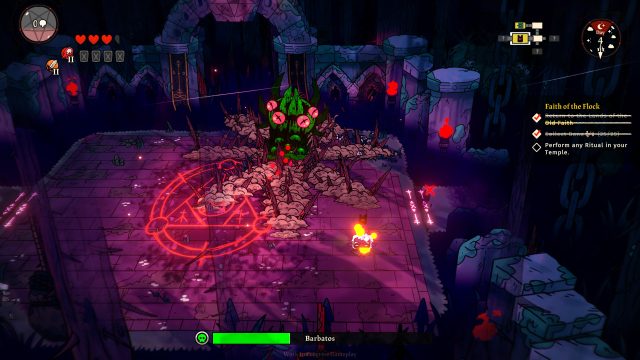
Devolver
The combat portions of the game play like a more forgiving and accessible cousin to the indie classic Binding of Isaac. The dodge-and-slash action on offer here is tight though nothing too original. But you’ll spend at least as much time in a town-building loop in which you’ll produce and harvest resources, perform favor quests for townspeople, and manage your cult’s general happiness and productivity—all while delivering sermons, silencing heretics, and performing anthropomorphic animal sacrifices.
There are dashes of Animal Crossing, Stardew Valley, and even Peter Molyneux’s Black and White in here. It’s all quite fun, but the cartoonish vision of running a cult in a world of Lovecraftian horrors is what really sells the game.
The art is top-notch, the music will get stuck in your head (in a good way), and the progression systems are just the right amount of addictive. Cult of the Lamb doesn’t reinvent a single wheel, but it’s a delicious cocktail of some of the best indie gaming has had to offer over the past few years—whether we’re talking about roguelite dungeon crawlers or the cozy game phenomenon.
In other words, it’s a “greatest hits” of popular indie game mechanics with a hilarious and original theme. As such, it’s worthy of your devotion.
-Samuel Axon
Dwarf Fortress
Bay 12 Games; Windows
The version of Dwarf Fortress that has existed for the last 16 years has been, well, off-putting. The default graphics were colored ASCII characters; onboarding relied on wikis and painful trial-and-error; and the inherent difficulty was also the game’s rallying cry: “Losing is fun.”
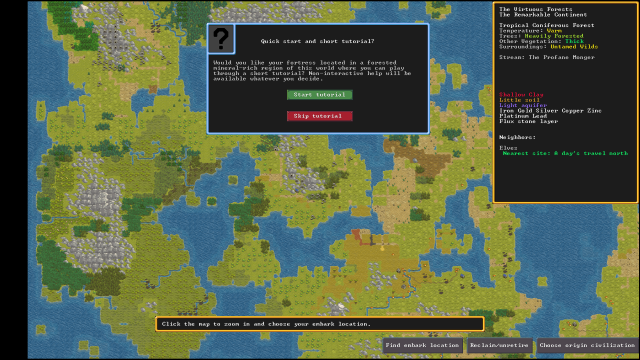
Bay 12 Games / Steam
Still, Dwarf Fortress’ unmatched complexity and epic storytelling potential gave it a devoted following and kept the game funded with donations—but barely. That makes the game’s modern-day “debut”—with 16-bit-style graphics, a wonderful soundtrack, tutorials, and optimized shortcuts—something of an invitation to newcomers. It’s also a chance for longtime fans to show their love for Zach and Tarn Adams, the brothers who have kept this crazy simulation running without ever actively selling the game.
The new, commercial version of Dwarf Fortress released this year is much easier to dig than the old version. Now, after your first few attempts at the game, you’re more likely to be left with a question like, “How do you find an encampment with sand that also has enough minerals?” rather than “What was that red Turkish-looking symbol and how did it kill my hunter?”
Yet despite the spit-shine, the tremendously deep systems and procedurally-generated mythical chaos are all still here, just with more reasonable ways of accessing and understanding them. (Which leads to another potential question: “Why does that cat get morose when it thinks about tables?”) This new version of Dwarf Fortress only adds to the charm of this already-impressive work and will hopefully bring the game to a wider audience that can better sustain it. We’ll all be better for it.
-Kevin Purdy
God of War: Ragnarok
Sony Santa Monica Studio; PS4/5
After four years, Ragnarok could have just provided more of the “Dad of Boy”-style God of War that we remembered and loved back in 2018. That game probably would have been in contention for a spot on this list.
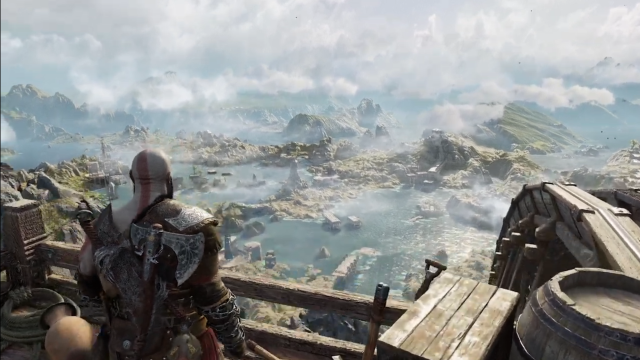
Sony
And yes, at its core, much of the gameplay and many of the environments in this sequel will feel familiar to fans of its predecessor. That’s not a bad thing; Ragnarok’s combat systems are as deep as ever, to the point that major new fighting options were being introduced nearly 20 hours into my playthrough.
But Ragnaork also stands on its own, thanks in no small part to its supporting characters. The Norse pantheon implied by the game’s title ably steals the show, trading subtle barbs and mythological drama throughout some delightful, scenery-chewing performances. While the relationship between Kratos and his pre-teen son Atreus doesn’t quite tug on the heartstrings this time around, there are enough intriguing side stories to cover up this relative deficiency.
The sequel does a good job with its varied pacing, too, switching to the nimble, bow-equipped Atreus or to extended puzzle-solving sections before Kratos’ standard axe-and-chain-swinging gameplay can feel too tiresome. And the wonderfully ornate environments shine through, especially on the PlayStation 5, practically begging you to explore every corner for plenty of hidden paths and storylines. Touches like that help push this sequel onto our list, even if it doesn’t quite live up to its predecessor.
-Kyle Orland

